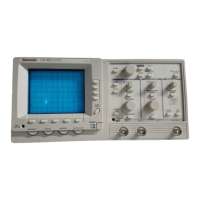TAS 200 Series Adjustment Procedures
Bench Test Instruments and Handheld Oscilloscopes Basic Service
33
4. Set the C H 2 VERTICAL INVERT push switch to the in position.
5. Set the VERTICAL MODE control to the ADD position.
6. Position the trace to the center horizontal graticule.
7. Adjust VR208 to obtain a flat line. See Figure 8 for the adjustment location.
Use the following procedure to adjust the MAG Sensitivity.
1. Set up the oscilloscope as follows:
VERTICAL MODE CH1 (CH2)
CH 1 (CH 2) VOLTS/DIV 2 mV
CH 1 (CH 2) VARIABLE CAL
CH 2 INVERT Out
CH 1 (CH 2) AC-DC DC
2. Connect a 10 mV
p-p
50 kHz square wave to the CH 1 (CH 2) input.
3. Adjust VR102 (VR202) to obtain a waveform five divisions in amplitude.
See Figure 8 for the adjustment locations.
4. Set the VERTICAL MODE to CH2 and repeat steps 2 and 3 for CH 2.
Use the following procedure to adjust the high frequency compensation.
1. Set up the oscilloscope as follows:
VERTICAL MODE CH1 (CH2)
CH 1 (CH 2) VOLTS/DIV 10 mV
CH 1 (CH 2) VARIABLE CAL
CH 1, CH 2 AC-DC AC
HORIZONTAL SEC/DIV 0.2 s
2. Connect a 20 MHz sine wave to the CH 1 (CH 2) input. Adjust the generator
output to produce a waveform four divisions in amplitude on the display.
3. Adjust VC105 and VC106 (VC205, VC206) for maximum waveform
amplitude. See Figure 8 for the adjustment locations.
4. Adjust VR103 (VR203) to obtain a maximum waveform amplitude. See
Figure 8 for the adjustment locations.
5. Connect a 1 MHz s quare wave to the CH 1 (CH 2) input. Adjust the
generator output to produce a waveform six divisions in amplitude on the
display.
6. Adjust VR302 and VC301 to optimize the waveform flatness. See Figure 9
for the adjustment location.
MAG Sensitivity
High Frequency
Compensation

